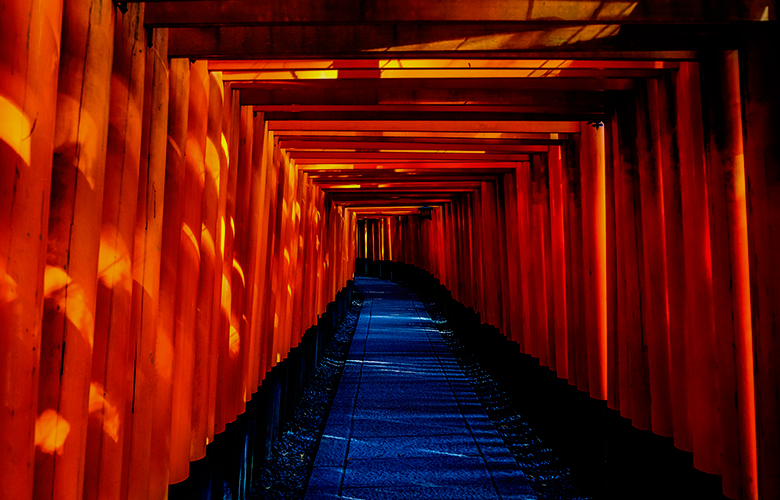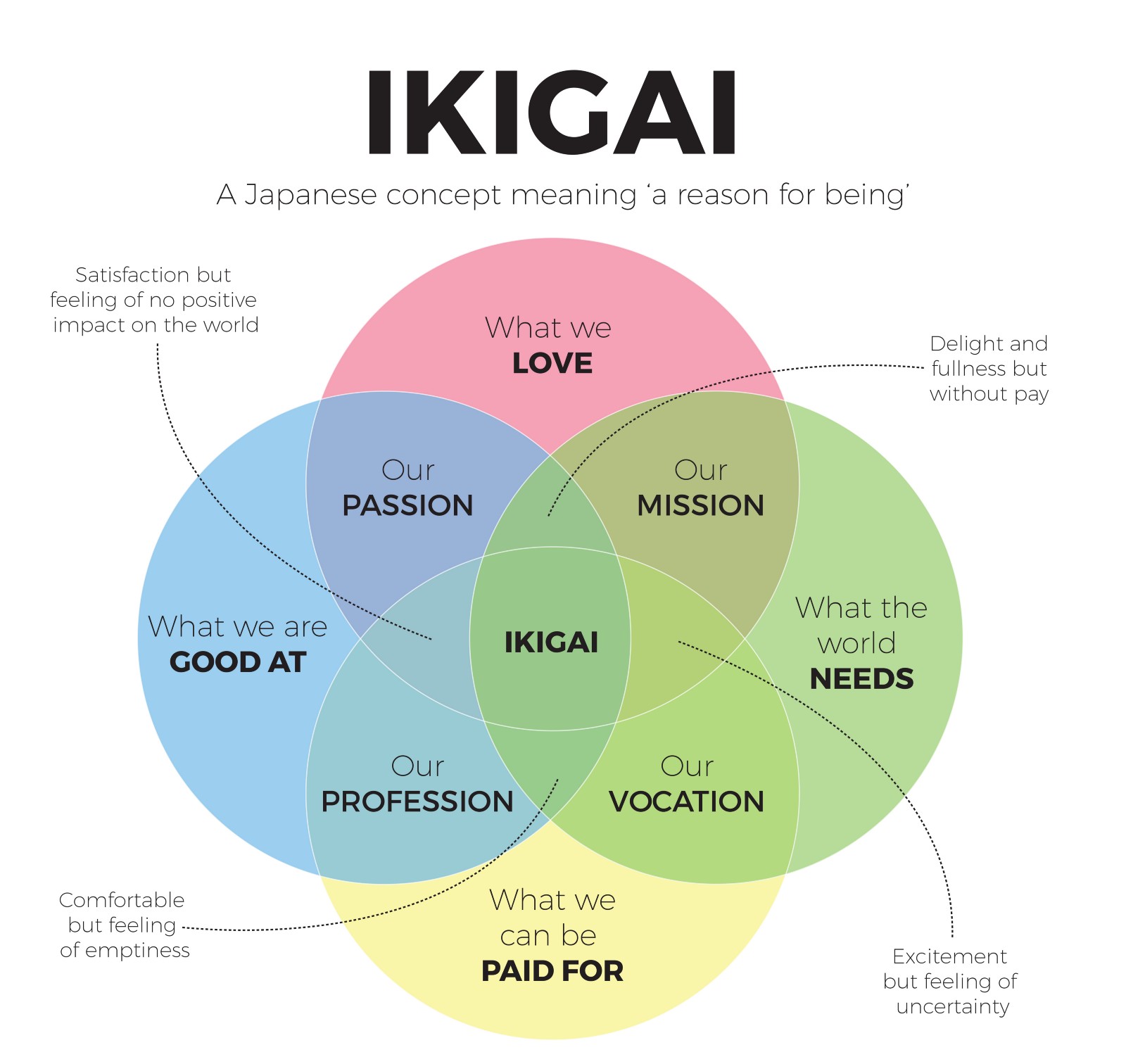
As a fellow Otaku, I’ve always found Japanese culture to be uniquely enlightening. Take the centenarians of Okinawa: Their ways of longevity have been at the center of scientific studies since well before the 21st century, with average life expectancies of up to 89 years for women – The highest in the world.
In addition to their clean and healthy dieting habits, Okinawans are also known for their ways of achieving and maintaining happiness. One factor that stands out to me is their concept of ikigai, which roughly translates to “the thing that you live for,” or “the reason for which you wake up in the morning.” Ikigai is not achievable with just one thing; rather, it is about bringing different aspects of life together in harmony. Watch this video for a brief explanation:
In many ways, ikigai encapsulates that basic human desire for fulfillment, but more than that, it splits up the idea of fulfillment into several categories. In order to have ikigai, the spiritual elements of your life must be balanced with the practical.

In the face of modern technological advances, it is natural to be concerned that our ikigai will get extinguished at scale as automation slowly rids us of all “inconvenient” work, as Tim Wu calls it. In his article for The New York Times, Wu uses this term to describe the tech industry’s battle for convenience. He claims that while convenience has long been a Utopian ideal (the “great liberator of humankind from labor”), “inconvenient work” has also been an important source of happiness, whereby hard work and labor are paid off with feelings of personal fulfillment.
For Wu, the state of modern convenience fails to acknowledge that difficult work is a constitutive aspect of human experience. I agree with his view that people have, indeed, become significantly more impatient, comparable to the type of reader that skips to the end of the book before they can decide if the journey is worth embarking on. While impatience is an inevitable result of being accustomed to increasing efficiencies, it’s worth remembering that by saving time and automatizing parts of production, it leaves more time for us to pursue leisurely activities.
Fear of change is a good thing – it makes us appreciate the things that are available to us in the present, but it would be a shame to deny automation its place in society simply because of our fear. Even Socrates wrote in 400 B.C.: “This discovery of yours [writing] will create forgetfulness in the learners’ souls, because they will not use their memories; they will trust to the external written characters and not remember of themselves.” While he was spot-on that our memory capabilities have declined from an ease of gathering information today, we can safely say that writing has had a net positive effect on the world.
Historically, we have always sacrificed certain skills in favor of new tech. Our ancestors in 10,000 B.C., for instance, became worse hunters the second they learned how to be great farmers, and the washing machine in 1917 made us all terrible at handwashing our clothes. William Blake, in the Restoration Era, put up a good fight against mass communication thanks to the spread of the printing industry. His handwritten and hand-drawn books of poetry are preserved to this very day (try finding one in a library near you). But alas, printing was here to stay and in fact, is already fleeting.

On and on it goes, we move from fearing one thing to the next. Yesterday, it was the Kindle that got the print community worried, today it is automation, and tomorrow – who knows?
The idea that automation and artificial intelligence may take away from our ikigai is not crazy, but it is also a sad admission that humans have limited capabilities, which I personally don’t believe. Our creativity is one thing that has not failed to surprise us throughout the course of history, and I believe in its ability to continue as society continues to progress. Whereas rationality was praised in a time of industrialism, creativity will come to count for the most in the age of automation.
According to the Obama Administration’s “Artificial Intelligence, Automation, and the Economy”, there is research that suggests that technological innovation over recent periods have increased the productivity of those engaged in abstract thinking, creative tasks, and problem-solving, which they believe are partial factors for the growth in jobs where these traits are valued.
With automation, rationality and accuracy are already taken care of by logical machines, but it is creativity that will constantly demand human effort so that systems already in place can be further improved over time. It is especially important to remember what Mike Sturm refers to as “the power of play”: In his article, he emphasizes the fact that humans are uniquely capable of “wandering for the sake of wandering,” and that it is especially in fields where we don’t see a need for creativity that are most wanting of a creative touch.
Innovation, the source of human progress, cannot be performed without creative minds. While technology may rid our lives of the fulfillment that arises from completing a menial task, it will also push us to focus on the thing that is irreplaceable in us. Our ikigai will no longer revolve around the ability to carry groceries instead of getting them delivered; rather, it will become dependent on how we choose to use our newly-discovered spare time, and how far we are willing to rack our brains for the next creative, world-changing idea.
Immersive Experiences: The Changing Landscape of Live Entertainment
Automation Anxiety: AI and Creativity


Andrew Gordon is the Vice President of Business Development at CAST Group of Companies. A strong proponent of innovation with over 15 years of experience, he has helped expand company objectives and exceed business goals. With BlackTrax Real-Time Tracking and CONVRG under his sleeve, Andrew is an expert in his field of automation and live entertainment technologies. An avant-garde early tech adopter, Andrew has become a trailblazer in the industry with an instinctual knack for foreseeing trends. As a highly motivated and forward-thinking individual with a big picture approach, Andrew has had the opportunity to work hand-in-hand with world-renowned brands such as Feld Entertainment, Cirque du Soleil and Disney, as he propels the team at CAST Software to record heights. With the belief that “Everything is and should be interconnected with tracking and automation at the centre of it all,” Andrew’s development skills and innovative ideas continue to surprise the industry.
Read Full Profile© 2021 TheatreArtLife. All rights reserved.

Thank you so much for reading, but you have now reached your free article limit for this month.
Our contributors are currently writing more articles for you to enjoy.
To keep reading, all you have to do is become a subscriber and then you can read unlimited articles anytime.
Your investment will help us continue to ignite connections across the globe in live entertainment and build this community for industry professionals.